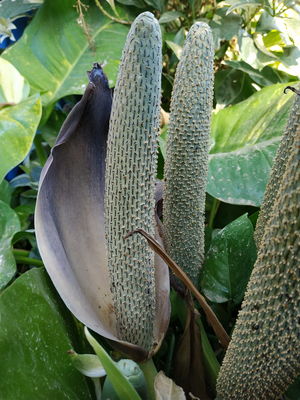Deciduous herb to 0.5 m tall. Subterranean stem a subglobose tuber, to 6 cm across × 4 cm high, tan outside, white inside. Pseudostem 10–17 × 1 cm, green, carmine or purple. Leaf solitary; cataphylls 2–10 cm long, pale carmine; petiole 15–35 × ca 1 cm, dark pink, sometimes with darker stripes; leaf blade trifoliolate; leaflets elliptic-ovate, 20–30 × 10–14 cm, margins undulate, apex acuminate ending in a short arista; central leaflet base convex, with a petiolule to 3.5 cm long; lateral leaflets slightly asymmetrical, base cuneate with a petiolule to 1.5 cm long, glossy medium green, with impressed veins above, paler underside with raised reddish veins. Inflorescence more or less held at foliage level; peduncle 15–25 cm long × ca 1 cm wide at the base, same colour as the petiole, or pale white-green; spathe tube cylindrical, to 5.5 × ca 2 cm, pale yellow-green to white with faint darker veins; spathe mouth margins hardly recurved, pale yellow-green; spathe limb horizontal, ovate, nearly the length of the tube, 4–6 × 4 cm, outside and inside yellow or light green, with a white spot, more or less conspicuous at the base; spadix appendix protruding from the tube, but shorter than the spathe, bent forward, 4–6 cm long, pale yellow-green, subulate, lower part conical, 4–5 mm wide, sessile, with long, yellow bristles, 1–1.7 cm long, in the middle part, and, in pistillate spadices, shorter and green projections, 4–8 mm long, just above the pistillate flowers; fertile zone staminate or pistillate, 2.5–3.5 cm long; staminate flowers loosely arranged, 2–3-androus, anthers tan or grey to pale orange, on a green stalk, 2–3 mm long; thecae dehiscing by an elongate pore; pistillate flowers densely arranged; ovaries ovoid, green; stigma on a short style, penicillate, white. Infructescence on an erect peduncle, subcylindrical, to 8 × 2.5 cm; fruits ca 1 × ca 0.7 cm, prismatic, apically flattened with stigmatic remains, red-orange when ripe. Seeds unknown.


